Aboriginal Art Special
April 22 - May 5, 2012
This trip is unique! Nowhere else can you take an extended trip through country so rich in art and scenery and have it interpreted by a traditional Aboriginal guide from the region.
Note. We originally organised the first section of this trip with someone at the Jawoyn Association in 2005. As good as we believe it is, we have never had the bookings we need to run it. Times change. After more than five years, we can no longer be sure that our original agreement holds. We will try and renegotiate the agreement when we have enough interest to make the trip a likely departure.
The dates listed here are based on our original tour. We may need to shift them to later in the dry season. Please ask for more information if that would be more suitable for you.
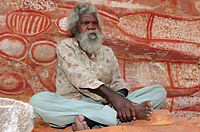
- Aboriginal Art This trip offers a relaxed way to examine some of the best Aboriginal rock art in the Top End.
- Aboriginal Guide At least one Aboriginal guide will accompany one or both sections of this trip.
- Seldom seen Most of the sites we visit are inaccessible to anyone who is not on an extended walk.
- Time Almost all of our trips visit art sites. This is the only one designed to specialise in the art and will spend extra time viewing the paintings.
The photos below give you a taste of what you can expect if you take part. The photos in the Jawoyn section and the one above were taken by Ray Whear of the Jawoyn Association.
Section 1: Nipbamjarn: April 22-28
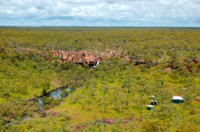
The Nipbamjarn camp, shown at left, is owned by the Manyallaluk Aboriginal Community. We will spend the first two or three nights there, getting acclimatised and visiting near by art sites.
The Jawoyn Association links below give more information about Manyallaluk and what is available there. The Manyallaluk art centre gives you the chance to purchase contemporary Aboriginal art from the community where it was produced without going through the usual middlemen.
- The Manyallaluk Community
- Manyallaluk Cultural Tours - our trip is a one-off special and is not listed on this page
- Manyallaluk Arts and Crafts Centre
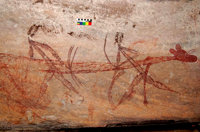
The photo at right shows some detail in one of the art sites we plan to visit. The coloured marker in the top centre is 10 cm long and shows just how large this painting is.
Dynamic style paintings such as the one above are seldom this large so this site is particularly significant both for its size and state of preservation. This style is thought to be quite old. The link below provides a good summary of the different styles we are likely to see on the trip. Kakadu Art Style page.
Below is the detail of a very different style and a photo showing it in context.
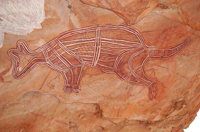
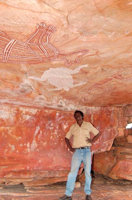
|
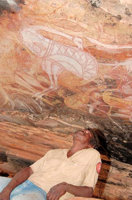
Although the Jawoyn lands are not as well known for their art as northern Kakadu, the photos here show you just how spectacular some of it is. These photos have been provided by the Jawoyn Association as being appropriate for public viewing.
We will not visit every site shown here, but we will visit a variety of sites including some that we cannot put on this website. Visiting the sites in the company of Aboriginal guides will give you a much better insight into the meanings of the paintings than anything you could do on your own.
Section 2: Kakadu: April 28 - May 5
If possible, we will organise an Aboriginal guide to accompany this section. If we succeed, our venue will be at their choice, possibly in Kakadu, possibly in Arnhem Land. If we are unable to get an Aboriginal guide, our walk will take place in the Baroalba area.
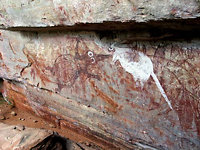
The Baroalba area contains the greatest concentration of Aboriginal paintings that we have found anywhere in more than 30 years of bushwalking in the Top End and Kimberley. The picture at left shows a large, naturalistic crocodile. This is believed to be one of the oldest styles. The description below is from the book Journey in Time by George Chaloupka. This is the best reference to the Aboriginal rock art in this region.
"In this shelter a freshwater crocodile (Crocodulus johnstoni) and the adjoining stylised white and red macropod are found superimposed over a number of earlier paintings of macropods some of which are larger than life. Freshwater crocodiles inhabit the plateau's streams but are found there today only in their pygmy form. As in this and other plateau shelters, they are depicted by paintings up to 5 metres long - the artists may have been portraying the Dreaming representations of this species. This shelter with three large representations of freshwater crocodiles, was identified as the freshwater crocodile Dreaming. Crocodile 340 cm."
The two photos below show the more recent stylised x-ray type paintings. Note how the turtle has been painted over previous paintings and the beeswax dots in the upper left on the fish painting.
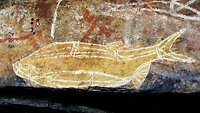
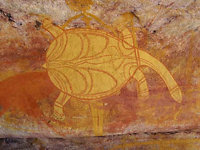
|
Despite its inaccessibility, another one of the Baroalba paintings, done in what Chaloupka calls the dynamic style, is one of the most famous in the park. Chaloupka describes it as follows.
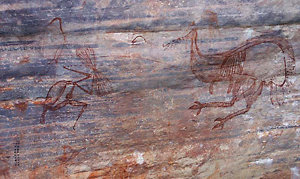
"The most accomplished example of this style, a masterpiece of world art, is the 'Emu hunt' composition. In this painting, a male figure wearing a long tasselled headdress and a hairbelt hides behind a hand-held bunch of grass as he stalks and spears an emu. The hurled spear pierces the emu inthe chest. The force with which he threw the spear, or its trajectory, is indicated by the dashes that extend from his still upraised arm, along the spear and into the bird's body. The dashes that emanate from the hunter's mouth may represent an exclamation of success while those that come from the emu's beak may be a call of pain or perhaps blood emission. This composition was executed by a master draughtsman, sketched with a brush and red pigment in confident and expressive lines. The emu is painted in considerable detail, with the long soft plumage and even the vestigial wings depicted. In composing this narrative scene, the artist first painted the hunter and then commenced to sketch in the emu, starting from the head. Realising that there was not enough room to include the spear, he repositioned the emu. Height of emu 93 cm."
Also note the beeswax dots in the lower left.
The photographs and what is written here can only hint as to what you will see on the trip.
Aboriginal Art Special detailed trip notes.
For more information about this trip or to find out how to book email us for Aboriginal Art Special Information
Want More Information?
If you would like more information about Aboriginal art and culture, we recommend the sites below in addition to the ones listed above.
The Australian Government Aboriginal Heritage page has some good background information as well as links to other sites with more detailed information.
Aboriginal Art Online has a number of pages of good background information. We particularly recommend
- Aboriginal Land and Cultures
- The Dreamtime. The Dreamtime is a widely used, but not well understood, term describing key aspects of Aboriginal spiritual beliefs and life.
- The Dreaming. The Dreaming is a term used by Aboriginal people to describe relations between the spiritual, natural and moral elements of the world. It relates to a period before living memory or experience - a time of creator ancestors and supernatural beings.
 share
share